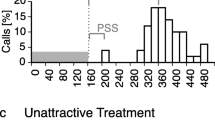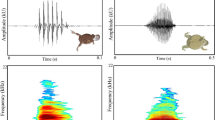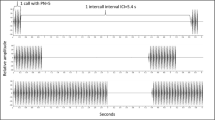Abstract
We studied female phonotaxis in gray treefrogs to learn how male aggressive calling influences female choice of a mate from the perspective of the aggressive signaler and his male target. Although aggressive calls on their own attracted some females, when allowed to choose, all females preferred advertisement calls to aggressive calls. We wanted to ascertain also whether such calls could reduce the attractiveness of a nearby advertising male relative to an advertising male that was not close to a male giving aggressive calls. If so, it would be a good reason for a male to move away from a male giving aggressive calls. We found that females were indifferent to aggressive calls which were broadcast following and adjacent to a source of advertisement calls when the choice alternative was a more distant source of advertisement calls. However, this was not always the case when aggressive calls and advertisement calls overlapped. Angular separation from a source of overlapping aggressive calls did not improve the attractiveness of advertisement calls relative to advertisement calls adjacent to a source of such aggressive calls. In a final test, we simulated an aggressive exchange with a winner and a retreating loser. Females allowed to eavesdrop failed to discriminate. Thus, there may be no cost to moving away and a potential gain in terms of reduced acoustic interference.
Significance statement
Loud calls or physical intrusions by conspecific males may cause male frogs to give aggressive calls. Although acoustic features of aggressive vocalizations may be well-described, we are largely ignorant of their utility and potential costs to producing and nearby males. We investigated whether the production of aggressive calls would compromise the attractiveness of male gray treefrogs to potential mates. Choruses of frogs may be especially suitable venues for eavesdropping, a phenomenon also ripe for investigation. Accordingly, we tested whether females exposed to simulated aggressive vocal exchanges would discriminate in favor of putative winners. We found that aggressive calling can reduce the signaler’s attractiveness but, lacking acoustic interference, not that of a neighbor. Females failed to discriminate between a simulated retreating loser and winner suggesting that such outcomes are irrelevant to females or that their ability to eavesdrop is limited.









Similar content being viewed by others
References
Akre KL, Ryan MJ (2010) Complexity increases working memory for mating signals. Curr Biol 20:502–505
Andersson M (1994) Sexual selection. Princeton University Press, Princeton
Aquiloni L, Buric M, Gherardi F (2008) Crayfish females eavesdrop on fighting males before choosing the dominant mate. Curr Biol 18:462–463
Backwell PRY (1988) Functional partitioning in the two-part call of the leaf-folding frog, Afrixalus brachycnemis. Herpetologica 44:1–7
Bee MA, Vélez A, Forester JD (2012) Sound level discrimination by gray treefrogs in the presence and absence of chorus-shaped noise. J Acoust Soc Am 131:4188–4195
Bertram SM, Rook VLM, Fitzsimmons LP (2010) Strutting their stuff: victory displays in the spring field cricket, Gryllus veleti. Behaviour 147:1249–1266
Bogert CM (1960) The influence of sound on the behavior of amphibians and reptiles. In: Lanyon WW, Tavolga WW (eds) Animal sounds and communication. Lubrecht and Cramer Ltd., Port Jervis, pp 137–320
Bower JL (2005) The occurrence and function of victory displays within communication networks. In: McGregor PK (ed) Animal communication networks. Cambridge University Press, Cambridge, pp 114–128
Brenowitz EA, Rose GJ (1999) Female choice and plasticity of male calling behaviour in the Pacific treefrog. Anim Behav 57:1337–1342
Bush SL, Gerhardt HC, Schul J (2002) Pattern recognition and call preferences in treefrogs (Anura: Hylidae): a quantitative analysis using a no-choice paradigm. Anim Behav 63:7–14
Doutrelant C, McGregor PK (2000) Eavesdropping and mate choice in female fighting fish. Behaviour 137:1655–1668
Dyson ML, Reichert MS, Halliday TR (2013) Contests in amphibians. In: Hardy ICW, Briffa M (eds) Animal contests. Cambridge University Press, Cambridge, pp 228–257
Fellers GM (1979) Aggression, territoriality, and mating behaviour in North American treefrogs. Anim Behav 27:107–119
Garcia MJ, Cronin A, Bowling T, Bushera H, Hunter KL, Taylor RC (2019) Dueling frogs: do male green tree frogs (Hyla cinerea) eavesdrop on and assess nearby calling competitors? Behav Ecol Sociobiol 7:21
Gerhardt HC (1981) Mating call recognition in the green treefrog (Hyla cinerea): importance of two frequency bands as a function of sound pressure level. J Comp Physiol 144:9–16
Gerhardt HC, Huber F (2002) Acoustic communication in insects and frogs: common problems and diverse solutions. University of Chicago Press, Chicago
Gerhardt HC, Tanner SD, Corrigan CM, Walton HC (2000) Female preference functions based on call duration in the gray treefrog (Hyla versicolor): influence of relative and absolute duration on preference strength. Behav Ecol 11:663–669
Gerhardt HC, Humfeld SC, Marshall VT (2007) Temporal order and the evolution of complex acoustic signals. Proc R Soc Lond B 274:1789–1794
Grafe TU (1995) Graded aggressive calls in the African painted reed frog Hyperolius marmoratus (Hyperoliidae). Ethology 101:67–81
Grafe TU (2005) Anuran choruses as communication networks. In: McGregor PK (ed) Communication networks. Cambridge University Press, Cambridge, pp 277–299
Hardy ICW, Briffa M (eds) (2013) Animal contests. Cambridge University Press, Cambridge
Hernandez-Jimenez A, Rios-Cardenas O (2012) Natural versus sexual selection: predation risk in relation to body size and sexual ornaments in the green swordtail. Anim Behav 84:1051–1059
Klump GM, Gerhardt HC (1987) Use of non-arbitrary acoustic criteria in mate choice by female gray treefrogs. Nature 326:286–288
Lippold S, Fitzsimmons LP, Foote JR, Ratcliffe LM, Mennill DJ (2008) Post contest behaviour in black-capped chickadees (Poecile atricapillus): loser displays, not victory displays, follow asymmetrical countersinging exchanges. Acta Ethol 11:67–72
Loranger MJ, Bertram SM (2016) The effect of male dominance on female choice in a field cricket (Gryllus assimilis). Anim Behav 114:45–52
Marshall VT, Humfeld SC, Bee MA (2003) Plasticity of aggressive signalling and its evolution in male spring peepers, Pseudacris crucifer. Anim Behav 65:1223–1234
Marshall VT, Schwartz JJ, Gerhardt HC (2006) Effects of heterospecific call overlap on the phonotactic behaviour of grey treefrogs. Anim Behav 72:449–459
Martínez Rivera C (2008) Call timing interactions, aggressive behavior, and the role of acoustic cues in chorus formation in treefrogs. Dissertation, University of Missouri, Columbia
Mennill DJ, Ratcliffe LM, Boag PT (2002) Female eavesdropping on male song contests in songbirds. Science 296:873
Mesterton-Gibbons M, Sherratt TN (2006) Victory displays: a game-theoretic analysis. Behav Ecol 17:597–605
Mowles SL (2014) The physiological cost of courtship: field cricket song results in anaerobic metabolism. Anim Behav 89:39–43
Oldham RS, Gerhardt HC (1975) Behavioral isolating mechanisms of the treefrogs Hyla cinerea and Hyla gratiosa. Copeia 1975:223–231
Perrill SA, Gerhardt HC, Daniel R (1978) Sexual parasitism in the green treefrog Hyla cinerea. Science 200:1179–1180
Pierce JR, Ralin DB (1972) Vocalizations and behavior of the males of three species in the Hyla versicolor complex. Herpetologica 28:329–337
Reichert MS (2011) Aggressive calling in treefrogs. University of Missouri, Columbia
Reichert MS (2013) Sources of variability in advertisement and aggressive calling in competitive interactions in the grey treefrog, Hyla versicolor. Bioacoustics 22:195–214
Reichert MS (2014) Playback tests and studies of animal contest dynamics: concepts and an example in the gray tree frog. Behav Ecol 25:591–603
Reichert MS, Gerhardt HC (2011) The role of body size on the outcome, escalation and duration of contests in the grey treefrog, Hyla versicolor. Anim Behav 82:1357–1366
Reichert MS, Gerhardt HC (2012) Trade-offs and upper limits to signal performance during close-range vocal competition in gray tree frogs Hyla versicolor. Am Nat 180:425–437
Reichert MS, Gerhardt HC (2013a) Gray tree frogs, Hyla versicolor, give lower-frequency aggressive calls in more escalated contests. Behav Ecol Sociobiol 67:795–804
Reichert MS, Gerhardt HC (2013b) Socially mediated plasticity in call timing in the gray tree frog, Hyla versicolor. Behav Ecol 24:393–401
Rosenthal GG (2017) Mate choice: the evolution of sexual decision making from microbes to humans. Princeton University Press, Princeton
Ryan MJ (2018) A taste for the beautiful: the evolution of attraction. Princeton University Press, Princeton
Schul J, Bush SL (2002) Non-parallel coevolution of sender and receiver in the acoustic communication system of treefrogs. Proc R Soc Lond B 269:1847–1852
Schwartz JJ (1986) Male calling behavior and female choice in the neotropical treefrog Hyla microcephala. Ethology 73:116–127
Schwartz JJ (1987) The importance of spectral and temporal properties in species and call recognition in a neotropical treefrog with a complex vocal repertoire. Anim Behav 35:340–347
Schwartz JJ, Gerhardt HC (1995) Directionality of the auditory system and call pattern recognition during acoustic interference in the gray treefrog, Hyla versicolor. Audit Neurosci 1:195–206
Schwartz JJ, Marshall VT (2006) Forms of call overlap and their impact on advertisement call attractiveness to females of the gray treefrog, Hyla versicolor. Bioacoustics 16:39–56
Schwartz JJ, Serratto Del Monte ME (2019) Spatially-mediated call pattern recognition and the cocktail party problem in treefrog choruses: can frequency differences help? Bioacoustics 28:312–328
Schwartz JJ, Buchanan BW, Gerhardt HC (2001) Female mate choice in the gray treefrog (Hyla versicolor) in three experimental environments. Behav Ecol Sociobiol 49:443–455
Schwartz JJ, Buchanan BW, Gerhardt HC (2002) Acoustic interactions among male gray treefrogs (Hyla versicolor) in a chorus setting. Behav Ecol Sociobiol 53:9–19
Schwartz JJ, Brown R, Turner S, Dushaj K, Castano M (2008) Interference risk and the function of dynamic shifts in calling in the gray treefrog (Hyla versicolor). J Comp Psychol 122:283–288
Schwartz JJ, Crimarco N, Bregman Y, Umeoji K (2013) An investigation of the functional significance of responses of the gray treefrog (Hyla versicolor) to chorus noise. J Herpetol 47:354–360
Schwartz JJ, Hunce R, Lentine B, Powers K (2016) Calling site choice and its impact on call degradation and call attractiveness in the gray treefrog, Hyla versicolor. Behav Ecol Sociobiol 70:1–19
Swanson EM, Tekmen SM, Bee MA (2007) Do female frogs use inadvertent social information to locate breeding aggregations? Can J Zool 85:921–932
Taigen TL, Wells KD (1985) Energetics of vocalization by an anuran amphibian (Hyla versicolor). J Comp Physiol B 155:163–170
Toledo LF, Martins IA, Bruschi DP, Passos MA, Alexandre C, Haddad CFB (2015) The anuran calling repertoire in the light of social context. Acta Ethol 18:87–99
Tuttle MD, Ryan MJ (1981) Bat predation and the evolution of frog vocalizations in the Neotropics. Science 214:677–678
Wells KD (2007) The ecology and behavior of amphibians. University of Chicago Press, Chicago
Wells KD, Bard KM (1987) Vocal communication in a neotropical treefrog, Hyla ebraccata: responses of females to advertisement and aggressive calls. Behaviour 101:200–210
Wells KD, Schwartz JJ (2007) The behavioral ecology of anuran communication. In: Narins PM, Feng AS, Fay RR, Popper AN (eds) Springer handbook of auditory research: hearing and sound communication in amphibians. Springer-Verlag, New York, pp 44–86
Acknowledgments
We thank Jason Herde, Norman Sanchez, Christine Elezaj, Katherine Cordero, David Johnson, Patrycja Dziuba, Sandra Gomes, Noah Davis, Omar Neyra, and Corey Ng for help in the lab and field. Gerlinde Höbel and two anonymous reviewers made helpful comments on an earlier version of the manuscript.
Funding
This work was supported with Pace University Scholarly Research Awards to JJS.
Author information
Authors and Affiliations
Corresponding author
Ethics declarations
Conflict of interest
The authors declare that they have no conflict of interest.
Ethical approval
The experiments performed comply with the current laws of the USA and were approved by the Animal Care and Use Committee of Pace University (protocol no. 2009-1).
Additional information
Communicated by A. Taylor Baugh
Publisher’s note
Springer Nature remains neutral with regard to jurisdictional claims in published maps and institutional affiliations.
Rights and permissions
About this article
Cite this article
Schwartz, J.J., Mazie, A.AB. Taxis bold as love: the influence of aggressive calls on acoustic attraction of female gray treefrogs, Hyla versicolor. Behav Ecol Sociobiol 74, 55 (2020). https://doi.org/10.1007/s00265-020-02836-x
Received:
Revised:
Accepted:
Published:
DOI: https://doi.org/10.1007/s00265-020-02836-x




